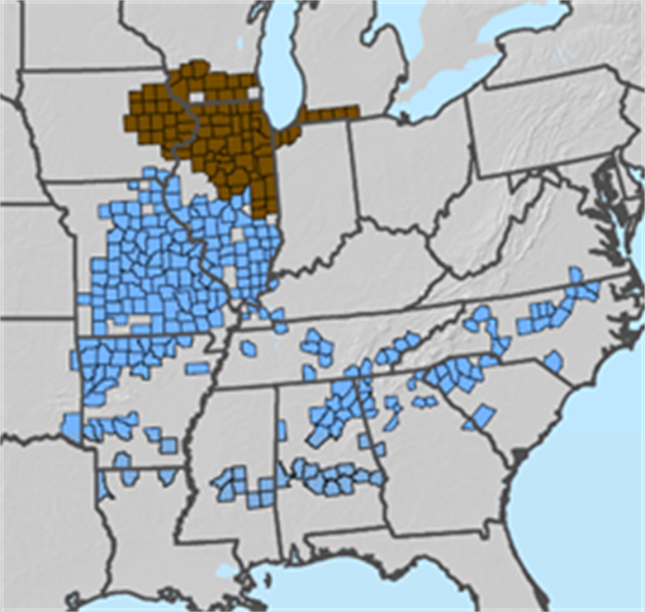The Amazing Cicada Emergences of 2024
This spring, portions of the Eastern United States will again experience one of Nature's great spectacles. Running from April to June, swarms of 13-year Brood XIX and 17-year Brood XIII periodical cicadas will create quite a buzz.
Where to expect the brood emergencies
Past emergence tracking can be seen in the following image from the USDA Forest Service.
13-year Brood XIX is shown in blue and expected to emerge in parts of AL, AR, GA, IA, IL, IN, KY, LA, MI, MO, MS, NC, OK, SC, TN, VA, WI and maybe Washington DC.
17-year Brood XIII is shown in brown and expected to emerge in parts of IA, IL, IN, MI, WI.

The Impact of Periodical Cicadas on Birds
• Adult cicadas are large, easily captured, and readily consumed by many bird species.
• Due to the abundant supply of periodical cicadas to prey upon, activity at bird feeders is likely to drop during the 6-7 weeks the cicadas are emerging and active.
• Long-term activity at bird feeders may increase due to the increase in bird populations (due mostly to increased fledging success) for the next one to three years.
• Long-term feeder activity may also increase due to increased tree damage and the subsequent loss of tree nuts and fruits.
• Studies have shown that some bird species experience one or more of the following impacts during periodical cicada emergence years:
- increased number of nests
- earlier breeding
- larger clutches
- increased nestling body mass
- increased rates of nestling survival
- significantly higher-fledging success
- Research has determined the following specific population changes:
Yellow and Black-billed Cuckoos’ populations increased to high numbers only during emergence years and then declined to average population levels by the following year.
Red-bellied Woodpeckers, Blue Jays, Common Grackles, and Brown-headed Cowbird populations increased significantly for 1-3 years following emergences and then declined to average population levels. - Red-headed Woodpeckers, American Crows, Tufted Titmice, Gray Catbirds, and Brown Thrasher populations show a significant population increase during the year following an emergence, and then stabilized to average population levels by the second year after the emergence.
Wood Thrushes, Northern Mockingbirds, Northern Cardinals, House Sparrows, Red-eyed Vireo, and Eastern Towhee showed insignificant changes to their populations during or after emergence years. - General Facts about Periodical Cicadas
• Periodical cicadas are found only in eastern North America.
• Periodical cicadas are different from the familiar annual cicadas which emerge from the ground every year and make their droning noise during the heat of late summer.
• Periodical cicadas differ visually from annual cicadas as they have very dark bodies (vs green), red eyes (vs black), red-orange wing veins (vs green).
• Many people know periodical cicadas by the name ""17-year locusts"" or ""13-year locusts,"" but they are not true locusts, which are actually a type of grasshopper.
• There are seven species of periodical cicadas including four with 13-year life cycles ree with 17-year cycles." - "The seven species of periodical cicadas emerge in separate groups in many different regions of North America over a variety of different years, thus creating 15 unique “Broods,” or year-classes.
- They appear above ground between mid-April and late May when soil temperatures reach approximately 64˚ F.
- Cicadas spend most of their lives underground. Near the end of their lifespan they emerge to climb trees, shed their exoskeletons, sing, fly and mate. Both females and males die soon after the females lay their eggs.
- Once they emerge from the ground, adult cicadas only live about two to four weeks.
- Adult male cicadas “sing” with their sound-producing tymbals on the side of their abdomen. The females try to seek out the singing males to mate.
- Female cicadas cut a series of Y-shaped slits into living tree twigs and lay up to twenty eggs in each.
- The eggs hatch in six to ten weeks; the nymphs then drop from the trees to burrow underground, find a root for feeding, and begin their 13- or 17-year development.
- Cicadas do not sting or bite; they are not poisonous or known to transmit disease.
- The emergence of massive numbers of cicadas is probably the cicadas’ defensive strategy to overwhelm their many predators, which are unable to consume more than a fraction of their total population.
- Forest areas within the emergence region of periodical cicadas suffer a 4% decline in growth rates during regular emergence years due to the heavy damage inflicted by the cicadas’ egg-laying behavior, killing the ends of many small branches.
- The carcasses of dead adult cicadas, present in large numbers in emergence years, provide a significant nutrient addition to forest soils, aiding in forest recovery.
Expert Resources about Periodical Cicadas - To learn more about the 2024 periodical cicadas go the UConn site here.
- Citizen’s science opportunity: To help document Brood XIII and Brood XIX emergences this spring, you can download the “Cicada Safari” app to provide
snapshots and follow research in real-time online. The app and additional information are at https://cicadasafari.org/"

